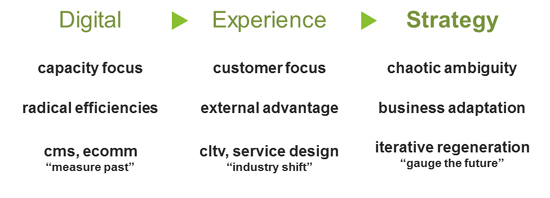Five Years In: Looking at the Rate of Change in Digital Business Transformation
Five years ago today, on Halloween, I was headed to London to keynote my second conference there in five months. It was one of those warm, magical nights with the feel that anything was possible. The iPad and apps were just emerging in to popular use, and the the huge shift ahead in mobile and social interactions was underway but still only partly appreciated.
So, its five years later, my teaching and work with have continued, as have innovations. Next week I’ll be at the Health Care Internet Conference (HCIC) in Las Vegas to debut some techniques and research I’ve worked on with my colleagues at Connective DX. Presenting primary research is a milestone for us, and for me it’s a natural moment to compare today to five years ago, and to imagine what’s around the corner for us all.
Back in 2011, conference topics were fairly tech-focused. The two topics that brought me to London were: “Is Mobile Really Going Shift the Digital World, How?” and “What is the Future of Messaging?” These really started with a technical hypothesis, and in each case got answered by looking at a pieces of customers’ experiences from a variety of industries. If you look at the deck below, most of what we talked about still holds up – but it perhaps the nods to the rising influence of customer experience are what connects best with today’s challenges.
Next week’s topic is a bit more specific than five years ago: “Can you score what makes a great hospital website from a patient’s perspective?” Sure, there’s a technical frame on this question too, but there’s a big difference. The influence of the customer’s experience already frames the conversation. Right out of the box, there’s a recognition that business outcomes and customer preference have to proceed together.
Healthcare Brands Start and End with Digital Experiences
Our world faces huge challenges, and all of them seem to run through healthcare. Compared to health, remaking advertising or travel was easy.
But the air is still thick with that vibe from five Halloweens ago. Change is possible in ways we couldn’t have foreseen then, not just because technology has changed, but because the leaders of these efforts are more accustomed to the patterns of digital business transformation proven in these other industries.
Conversely, if a patient can’t step through a clear, frictionless and well-thought-out digital experience on a hospital’s public website, what does that say about the hospital’s commitment to patient care when they show up for a procedure? After all, in our digitally hybrid lives, every part of care, from selecting provider options, to navigating a complex hospital campus, to updating family members on treatment, and supporting after care may now have critical digital components.
Only so many people can ever travel through a hospital’s halls, and those visits have to be limited in their frequency. But thanks to mobile devices, telecommunications and data monitoring – patients and their doctors can have more frequent better informed clinical exchanges through digital channels.
The question is less if channels can be made to work individually, than how they can help organizations do a better job. The digital challenge isn’t to describe the value of products digitally, but rather to increased their value with new digital experiences and features.
From Efficiency, to Customer-Centricity to Digital Transformation
The process of digital shift often starts out rooted in efficiency. And it can end there, unless that shift creates broad connection points in which both the company and customers gain efficiencies together. That’s exactly what’s happening in healthcare right now.
This always on connection makes consumers more addressable, but also more knowledgeable and open to a range of ancillary services. And organizations find they are better able to evolve to follow the needs of their buyers beyond the foundation of their initial areas of service.

As firms become more both digitally adept and closer to customers, the realize their advantage is rooted in their position with customers as much as any specific clinical skill. This is where transformation happens, and firms follow the needs of their customers in ways that cross industry boundaries.
As hospitals turn from treatment to wellness – parts of their businesses may function as digital fitness platforms or in-person fitness facilities, medical or device R&D partners, sources of health food, financial planning, insurance, consumer packaged goods and B2B consulting and business process outsourcing. In short, the Hospital of the future may be part YMCA, Whole Foods, Apple Genius Bar, Walgreens, Charles Schwab, Blue Cross, and McKinsey. Five years ago, everyone thought they knew what a hospital was and that their websites were peripheral. The old constraints are falling, and healthcare leaders are using digital tools to remake their organizations.

Credit: Steven Depolo
https://www.flickr.com/photos/stevendepolo/4550901923
The Change is Still Just Starting
How much change still lies ahead? Consider that that main way most us share thoughts digitally is by typing through QWERTY keyboards which were designed to slow typing so metal keys on typewriters wouldn’t collide. Everyone who thinks about this for two minutes will realize this is entirely arcane.
Does that mean keyboards are going away? No, calligraphy pens, sandwich boards, and horse whips are all still around – they just enjoy less generalized use than they once did.
Alexa, just get me what I want
The visual layer of the web seems over-stretched. Simply asking my devices for what I want is often far easier than navigating to it visually. And small acts of cognitive computing – such as Uber auto-populating my destination to home when I’m in the office at the end of a work day, are a simply ways our hybrid technical worlds will be easier to live with than the web-based screens that while awesome, still don’t fit with daily life.
For some time we’ll be in that a built-in fooling around which is just part of saying “Hello World” with any new technology. Virtual Reality, voice input, sensing and an internet of things are amazing platforms for change – but the real accelerator is the imagination and ambition that digital leaders already have today. That’s the big difference, real business leaders expect to contend with the forces of transformation – and they’re on the look-out for the the next big thing that will advantage their relationship with the people the care about.

 The future of digital experiences will be built by strategists who grasp the full array of emerging business, social, and technical models. Specialties in user experience, branding, application design, and data science are laying the foundation for richer user experiences and business models breakthrough products and revenue based marketing.
The future of digital experiences will be built by strategists who grasp the full array of emerging business, social, and technical models. Specialties in user experience, branding, application design, and data science are laying the foundation for richer user experiences and business models breakthrough products and revenue based marketing.
5 Responses to "Five Years In: Looking at the Rate of Change in Digital Business Transformation"
August 31, 2020
If you are alone and if you are looking for some sexy company try to visit pleace where sexy young girls wating for chat with you – sex frankfurt
May 31, 2022
Wow, I love it! Thank you so much for sharing
August 4, 2022
Wow, I love it! Thank you so much for sharing
November 17, 2022
Transitioning into digital business is difficult if not impossible for some people, just ask someone who does gas appliance repair
for a living.
December 9, 2022
Wow, I love it! Thank you so much for sharing